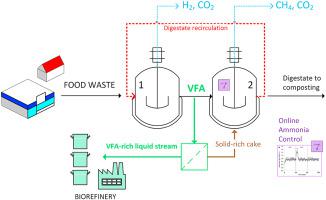Journal of Cleaner Production ( IF 9.7 ) Pub Date : 2020-09-18 , DOI: 10.1016/j.jclepro.2020.124297 Federico Micolucci , Marco Gottardo , David Bolzonella , Paolo Pavan , Mauro Majone , Francesco Valentino

|
A combined two-levels control method has been developed and tested on a long term operation of a two-phases pilot-scale anaerobic process for the concurrent production of volatile fatty acids, hydrogen and methane. The latter was designed for the treatment of food waste of urban origin (namely, the organic fraction of municipal solid waste). The optimized control method was set on the base of the inputs of three online probes: a pH-meter in the fermentation reactor, a pH-meter and a conductivity probe in the digestion reactor. The first control level managed the pH in the fermentation reactor while the second control level managed the ammonia concentration in the digestion reactor. This combination established the volume of the digestate to be recycled from the digestion to the fermentation reactor, optimizing the yield of volatile fatty acid (0.31-0.32 kg CODVFA/kg CODfed) and the specific hydrogen production (SHP; 0.070-0.074 m3 H2/kg TVSfed) in the fermentation reactor and the specific methane production (SMP; 0.48-0.55 m3 CH4/kg TVSfed) in the digestion reactor.
A new process configuration was also proposed and applied over the course of the long operation period. This configuration allowed to remove part of the volatile fatty acid-rich liquid stream from the fermenter effluent, maintaining the corresponding solid-rich effluent in the whole system (as feed for the digestion reactor) by using a solid/liquid separation unit. In this way, the concentration of volatile fatty acids in the digester was kept at a low level, even with high loading rates, so maintaining a satisfying efficiency of methane production and utilising the excess volatile fatty acids (out of the system) as building blocks for other purposes.
The optimized two-levels control method for the anaerobic treatment of food waste provides new perspectives for the valorisation of such waste stream; the production of building blocks namely volatile fatty acids supports new innovative bio-refinery platforms for the production of bio-products.
中文翻译:

中试规模的多用途方法,用于通过自动控制的厌氧工艺生产挥发性脂肪酸,氢气和甲烷
已经开发了一种结合两级控制方法,并在两阶段中试规模厌氧工艺的长期运行中进行了测试,以同时生产挥发性脂肪酸,氢和甲烷。后者被设计用于处理城市食物垃圾(即城市固体垃圾的有机部分)。基于三个在线探针的输入来设置优化的控制方法:发酵反应器中的pH计,消化反应器中的pH计和电导率探针。第一控制水平控制发酵反应器中的pH,而第二控制水平控制消化反应器中的氨浓度。这种结合确定了从消化液循环回发酵反应器的消化液的体积,从而优化了挥发性脂肪酸的收率(0。进料中的VFA / kg COD )和发酵反应器中的特定氢气产量(SHP; 0.070-0.074 m 3 H 2 / kg TVS进料)和特定的甲烷产量(SMP; 0.48-0.55 m 3 CH 4 / kg TVS进料)在消化反应器中
还提出了一种新的工艺配置,并在较长的运行期间内得到了应用。这种构造允许通过使用固/液分离单元从发酵罐流出物中除去部分富含挥发性脂肪酸的液体流,从而在整个系统中保持相应的富含固体的流出物(作为消化反应器的进料)。这样,即使在高负载率下,蒸煮器中的挥发性脂肪酸浓度也可保持在较低水平,因此可保持令人满意的甲烷生产效率,并利用过量的挥发性脂肪酸(系统外)作为基础用于其他目的。
用于食物垃圾厌氧处理的优化的两级控制方法为这种垃圾流的增值提供了新的视角。建筑构件即挥发性脂肪酸的生产支持了用于生产生物产品的新型创新生物精炼平台。











































 京公网安备 11010802027423号
京公网安备 11010802027423号